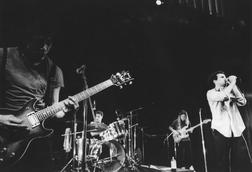Dec 22, 2011 4
Homage to Saccharine Trust
Until the appearance/Of a lone ocean bird/Skimming over the choppy water/Airily eyeing after anchovies/And occasionally glancing at the people/Who had come to be at the beach/On the winter solstice – from “Estuary,” by Saccharine Trust
 I think it was in the late summer of 1981 that I jokingly suggested to my friends that we go see a concert at the Whiskey A Go Go featuring the Minutemen, Saccharine Trust, and the Meat Puppets. I had not ever heard any music by these groups and was probably just amused by their names, especially the Meat Puppets.
I think it was in the late summer of 1981 that I jokingly suggested to my friends that we go see a concert at the Whiskey A Go Go featuring the Minutemen, Saccharine Trust, and the Meat Puppets. I had not ever heard any music by these groups and was probably just amused by their names, especially the Meat Puppets.
Who knew, then, that some four years later these would actually be among my favorite bands?
Indeed, it was in the spring of 1985 that I went to see the Keystone Palo Alto installment of what SST billed as “The Tour.” The bands involved? SWA, Saccharine Trust, The Meat Puppets, the Minutemen, and Husker Du. I had gone mainly to see the Minutemen, having had my mind blown over the preceding months by their magnum opus, Double Nickels on the Dime.
The Minutemen totally rocked, as they did every single time I saw them. SWA was forgettable. The Meat Puppets, oddly enough, left no impression (though later in my life I devoted significant turntable time to Meat Puppets II and Up on the Sun, and, in fact, if I were inclined to recommend any band from that era now, it would probably be them). Husker Du were a white noise blur and my rock concert companion (Eric!) and I left during their set.
The band that ended up haunting me, however, was Saccharine Trust. Jack Brewer, the singer, was dressed in a banana yellow leisure suit; Joe Baiza, the guitarist, had a piece of spin art taped to his guitar. They produced a very angular and spastic kind of punk noise with Baiza given to hacking out long, experimental lines while Brewer—curly haired, baby faced—spit his beat-inspired words. At one point, Brewer hit himself in the forehead repeatedly with the mic until it drew blood. Later, he took off his belt, tied it around his neck, and awkwardly jerked himself into the air with it over and over again.

